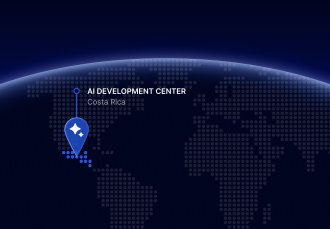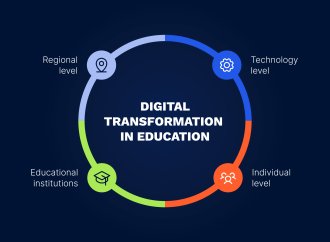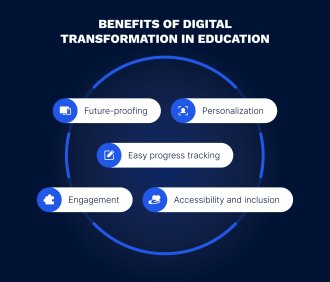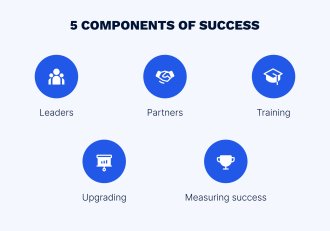
Contact us
Our team would love to hear from you.

Education is becoming increasingly accessible and engaging, with more advanced solutions being made available to serve the teaching and learning processes, and educational institutions need to adopt digital tools to provide their students with the digital skills required for the modern-day workplace.
This article offers an overview of the digital transformation taking place in the education sector, the emerging trends in educational technology, the benefits that these innovations offer, the challenges organizations may encounter, and, finally, ways to ensure that a digital transformation initiative within an educational institution succeeds.
Digital transformation is the fundamental rewiring of an organization that involves developing a new digital business model and related strategies, based on the integration of advanced technologies.
In the education sector, this means much more than gaining a competitive advantage, it provides an opportunity to address individual and global issues, such as the issue of students with limited access to education, driving to ensuring education for all, and enhancing the quality of the education offered.


Digital transformation in education happens on four levels: technologies, individuals, educational institutions, and regional. The technology level implies a technology-driven approach embraced by all the participants in the process, the individual level comprises students and teachers who apply these tools, educational institutions are the driving force behind the changes, and, at the regional level, we find the legislative force that governs the transformation and the funding that enables it. All four levels are interconnected and a transformation at one level entails modifications to the other three.
A key characteristic of digital transformation in education is that it involves the constant modernization and modification of educational methods and administrative procedures. This contrasts with the traditional approach whereby educational institutions adopt a program or a strategy and stick with it.
Technological trends are continuously changing the way educational institutions work. The following are six prominent technological trends in education that can significantly improve processes.


This technology is used to produce machines that can understand language, recognize pictures, learn, and solve problems. AI is rapidly occupying a valuable place in our day-to-day lives, supporting, augmenting, and automating human activities.
The solutions enabled by AI will change the education sector as well, enhancing the learning and teaching experience. According to a survey by the Capgemini Research Institute, more than half of school teachers in Australia, Finland, France, Germany, Japan, the Netherlands, Singapore, the United Kingdom, and the United States believe that AI tools will improve their work by automating administrative tasks and supporting teaching practices. Here are some use cases for AI in education.
AI-powered solutions allow educational institutions to adapt programs and develop personalized lessons and automated curriculums, based on an analysis of students’ progress, knowledge, and skill level.
AI tools can assess students’ work, determine their weak points, and highlight topics that need more attention, as well as identify students who may be at risk of dropping out so that teachers can help them keep up with the program.
AI can be used to power student advisory services that manage common or simple inquiries, allowing teachers, guidance counselors, and administrative personnel to focus on the more complex issues.
ML is a subset of AI that enables machines to use algorithms to learn from patterns in data, imitating the way humans learn. Since many educational processes are based on information, ML algorithms and advanced analytics can help use this information to solve numerous burning issues, e.g., efficiently use the accumulated data, accurately assess student performance, and automate repetitive processes. ML can be used in education in the following ways.
Educational institutions can employ ML to provide students and teachers with study guides, lecture notes, practical activities, and solutions, increasing the effectiveness of the learning process.
Institutions can forecast enrollment numbers, identify students who are most likely to succeed, and those most at risk of expulsion who will require extra support, all using ML algorithms.
Many repetitive administrative activities can be easily automated with the help of ML, providing educators and other personnel with valuable time to attend to other tasks.
AR and VR provide an immersive experience for students, allowing projecting content into the surroundings and giving access to various virtual scenarios and environments. These technologies support engagement, concentration, and creativity, increasing motivation and participation. In a survey, McKinsey discovered that students in higher education institutions are most excited about AR and VR tools that are going to make the learning experience more entertaining. The following are some AR and VR application cases in education.
Educational institutions can integrate AR and VR in their classrooms to simulate situations, display concepts in a comprehensive way, explore different phenomena up close, or even experience a simulation of a historical event.
AR and VR are already widely used to train professionals such as pilots and surgeons. Many fields of work require hands-on experience that can be acquired in a low-risk interactive setting with the help of this technology.
This is another one of the digital transformation trends in education that promotes student engagement. Gamification implies integrating gaming elements into the learning process. Through digital games, learners build their cognitive abilities and acquire valuable knowledge and skills by identifying obstacles, solving issues, and making critical decisions.
Gamification brings many benefits for students and teachers even if, at first glance, this trend may appear to center on entertainment. The main advantage is the motivation that is developed through challenges, quests, and reward systems. Digital games encourage learners to achieve goals, interact with one another, and accomplish learning objectives, all while providing instant feedback that allows them to quickly correct any mistakes.
IoT is a system of devices linked via the Internet, an organization’s intranet, or some other network. This technology is gradually gaining popularity among educational institutions, enabling improved connectivity, community building, and enhanced security. IoT solutions help students and educators to engage with each other and access learning materials, enhancing interaction and productivity, as well as allowing organizations to securely control the environment. In education, IoT can be used in the following ways.
IoT can turn classrooms into advanced learning spaces where students can interact with the content, educator, and each other. The teacher’s computer, a smart whiteboard, tablets, laptops, VR headsets, and other digital equipment provide an engaging and flexible environment for students and educators.
The learning experience is significantly impacted by the learning environment, and through IoT, educational institutions can monitor the premises to control the temperature, lighting, ventilation, air quality, and other aspects to create a pleasant and safe environment for students and teachers. Security systems also include access control and visitor management and enable rapid emergency response.
Blockchain is a decentralized ledger that is used to record transactions and exchange information and assets without intermediaries. The key aspects of blockchain are decentralized governance, immutable records, encryption, distributed ledger technology, and tokenization. In the education sector, this technology has the potential to streamline certain processes, such as payments and record keeping. Here are some popular use cases.
Blockchain-powered smart contracts are self-executing agreements that can be used throughout the whole educational process, from enrollment to exams, thereby simplifying administrative tasks. In practice, a student who enters into a smart contract with an educational institution can only access the course materials once payment is made, and is only eligible to take the exams once they have completed the course. All these conditions are predefined in the contract, which enhances operational security and transparency. Furthermore, course materials stored on the blockchain are easy to manage and distribute. This solution can also benefit online-learning platforms and education institutions with a remote learning option.
Educational institutions can use the blockchain to securely store academic records, courses taken by an individual, their attendance record, test results, and overall performance. Access to the records can then be granted to other parties, such as other institutions or potential employers, for the purposes of record confirmation and ID checks.

Our design and development teams helped create an engaging experience for e-learning platform users.
Digital transformation in teaching and learning processes offers new opportunities to educational institutions.


A digital environment helps teachers engage students in the learning process and motivate them to deliver better results. A simple whiteboard may not be enough to keep learners interested, whereas various technical solutions impact their attitudes and make them more invested in discussions, interactions, collaboration, research, and learning. Educational games and other digital materials and tools inspire students to solve problems, spend more time on their studies, and improve their comprehension of the material.
It is sometimes difficult for teachers to see the reasons why a certain student is unable to keep up with the curriculum. This issue is addressed by tools that can track and analyze student performance in real time. Advanced solutions help identify the areas in which a student is struggling, their strengths and weaknesses, and if they are at risk of dropping out. This information allows educators to adjust the learning program and spend more time with learners who are finding the course difficult.
Education is a basic human right that is yet to become accessible in every part of the world. However, with the development of digital technologies, more and more students will have the opportunity to learn and receive education, not only those with specific needs, but also those who encounter political, economic, or socio-spatial barriers. Online learning platforms, speech-to-text and text-to-speech technologies, and other digital solutions facilitate the learning experience.
To increase inclusion in the learning process, teachers and institutions need to examine the educational conditions and individual capabilities of the students and select the digital tools most suitable for the environment provided.
While the traditional teaching model requires students to follow one curriculum, which may result in some of them lagging behind or getting ahead of their peers, technology makes it possible for everyone to learn in a way that is most suitable for them and at a comfortable pace. Using digital tools, educators can develop personalized programs for students who are having trouble with a certain subject, who are running into obstacles, or who are particularly gifted. Digital technology can also help students adapt and gain control over certain aspects of their studies.
This does not necessarily mean the individualization of learning, but rather a cooperation between teacher and student where the student takes more responsibility over time, managing their own learning process with the help of digital tools.
Digital skills are essential for nearly all professions, and educational institutions should prepare students for entering the workforce. The Capgemini Research Institute conducted research in secondary schools across nine countries (Australia, Finland, France, Germany, Japan, the Netherlands, Singapore, the United Kingdom, and the United States) and discovered that students aged 16-18 are most confident with basic digital skills, such as using computer apps and finding information online. However, fewer of them believe they have the digital communication and data literacy skills required to succeed in the workplace. The necessary skills are developed by constantly working with the digital technologies and using them both in and outside the classroom.
While there are many potential benefits of digitalization in the education sector, there are also risks related to the transformation process. Here are some challenges to consider.
Strategy drives digital transformation, so it is essential to develop one that is clear and suitable for the organization. This involves setting goals and objectives, creating a detailed roadmap with room for change, and selecting the tools and technologies that are going to be valuable in serving those goals and objectives.
The pace of change also plays a significant role in successful digital transformation. Rushing the transformation can lead to poor results but moving too slowly can mean falling behind the competitors. The strategy needs to be carefully planned, considering all accessible resources and the best industry practices.
According to a survey by McKinsey, a lack of awareness of digital technology is one of the main barriers to the adoption of innovative learning tools in schools and higher education institutions. It is still not common for teaching staff to implement advanced technology solutions as many educators are used to the traditional methods and have little knowledge of the tools that are now available, and how these tools can facilitate both the teaching and learning experiences.
Limited knowledge usually goes hand in hand with limited capabilities. Many educational institutions are not prepared to embrace digital transformation due to a lack of digital competence. Many teachers still need guidance and training to be confident and well-versed in digital skills. A global UNESCO survey of over 450 schools and universities found that fewer than 10% have developed institutional policies and formal guidance concerning the use of generative AI, which is one of the more popular innovative technologies.
Teaching staff are responsible for creating a learning environment free from any barriers and respecting students’ needs and levels of knowledge, while for students, developing their digital skills helps them prepare for future jobs and improves their employment prospects.


In any industry, digital transformation relies on leaders, the talented and skilled individuals who act as guides into the digital world. They help prepare an educational institution for the transformation, set goals, distribute roles and responsibilities, and select and integrate the necessary digital tools and methods into the teaching and learning processes.
It’s also important to choose the right partners, with experience in digital transformation in the educational domain, to deliver the solutions in accordance with the goals and values of the organization and ensure that the incorporation of the implemented tools goes smoothly.
Digital leaders or partners can also train staff on how to use the new tools, why they are important, and how these tools enhance teaching and other activities. While some tech-savvy educators may feel comfortable with digital technology, others need support in practicing their digital skills and adapting their course delivery accordingly.
A good practice that empowers a successful digital transformation in educational institutions is constantly upgrading the adopted tools and integrating new ones. Gradually, educational organizations will embrace the new solutions and let go of old ineffective methods.
Finally, it is important to develop a way of measuring success. In education, the impact of technology can be assessed by student engagement and accomplishment, tool usage, and instructors’ satisfaction with these tools. This assessment can also help develop new strategies on integrating other technology solutions.
Digital transformation is a complex process which is much more than just technology, it requires involvement on all levels—from stakeholders and educational institutions to teachers and students—in becoming a major turning point for the organization. A complete modification of the education sector, empowered by innovative digital tools, will allow teachers to provide a comprehensive, engaging, and immersive learning experience for all students and prepare them for the future. It also gives learners with disabilities, or students from linguistic and cultural minorities, an opportunity to receive an education. To lead a successful digital transformation, skillful leaders, experienced partners, training staff, and constant upgrades are critical factors.
EffectiveSoft can be your partner on the digital transformation journey. To learn more about digitalization and our expertise in the field, contact our team.

The first step in creating a digital transformation strategy is conducting a comprehensive needs assessment. This involves understanding the current state of technology use within the institution, identifying gaps, and defining clear objectives aligned with the institution’s mission. A detailed inventory of existing tools, systems, and processes helps identify redundant or outdated technologies that need to be upgraded or replaced.
Next, the institution must prioritize investments and develop a phased roadmap. This includes setting short- and long-term goals, choosing scalable technologies, and ensuring that adequate training is part of the plan. The roadmap should account for resource allocation, timelines, and measurable KPIs to track progress.
Digital transformation enhances accessibility by leveraging technology to remove barriers to education for students with disabilities and those in remote areas. For example, tools like screen readers, speech-to-text systems, and alternative input devices enable students with visual, auditory, or physical impairments to access educational content.
Moreover, the use of adaptive learning platforms personalizes content delivery to match diverse learning needs. These systems analyze individual performance and tailor instructional materials accordingly.
EffectiveSoft can leverage its expertise in software engineering, technology IT consulting, and building customized solutions. Here’s how we can contribute:
Can’t find the answer you are looking for?
Contact us and we will get in touch with you shortly.
Our team would love to hear from you.
Fill out the form, and we’ve got you covered.
What happens next?
San Diego, California
4445 Eastgate Mall, Suite 200
92121, 1-800-288-9659
San Francisco, California
50 California St #1500
94111, 1-800-288-9659
Pittsburgh, Pennsylvania
One Oxford Centre, 500 Grant St Suite 2900
15219, 1-800-288-9659
Durham, North Carolina
RTP Meridian, 2530 Meridian Pkwy Suite 300
27713, 1-800-288-9659
San Jose, Costa Rica
C. 118B, Trejos Montealegre
10203, 1-800-288-9659